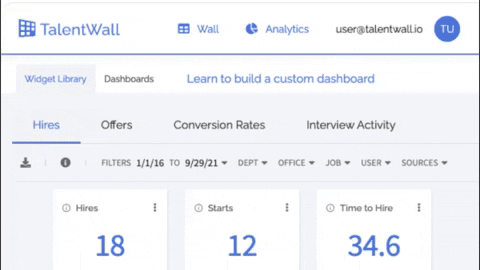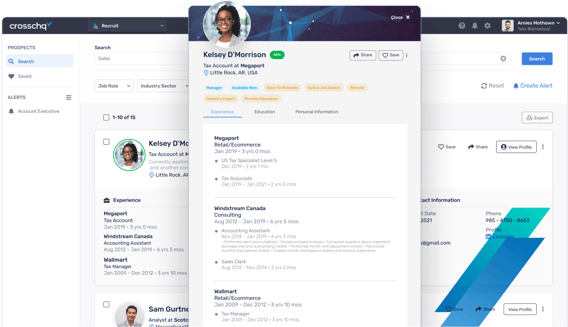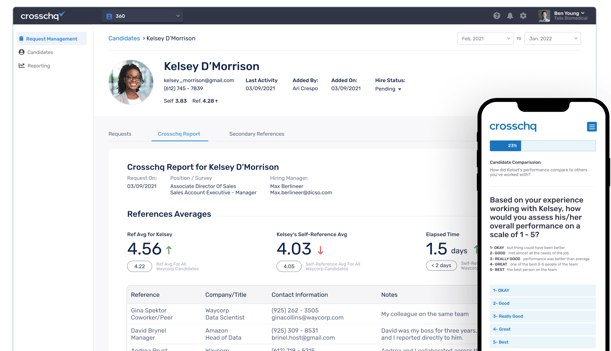

Crosschq Blog
A Guide to Fixing the Differences Between Recruiters and Hiring Managers

What is the difference between a recruiter and a hiring manager? Is there a meaningful difference? How can both parties work better together for a streamlined hiring process?
Many people oversimplify the difference between a hiring manager and recruiter by saying one is an in-house employee making final calls on new hires, and the other is a contracted freelance recruiter or firm sourcing candidates and sending them down the funnel.
However, the difference between a recruiter and a hiring manager isn’t a job title, or simply whether they are inside or outside an organization. Rather, each has a distinct role to play, but neither can accomplish their goals without the help of the other.
What is a Hiring Manager?
A hiring manager is a person inside an organization who is tasked with filling empty roles, and who makes the final decisions on whether a candidate receives an offer. In some cases, their sole purpose in the company is hiring.
These hiring managers are struggling with unprecedented tightness in the labor market and candidate demands. Many say they struggle with ineffective and unstructured hiring processes, and 84% of full-time hiring managers say they are burned out.
In other cases, hiring managers are in some role that will place them in a supervisory position over whoever is being hired. These hiring managers can be a division head, a department manager, or (more rarely) a person attached to the human resources department.
In some cases, individual team leads will be put in the position of the hiring manager when expanding their team, with limited oversight from someone above them in the chain of authority. This type of delegation is common in organizations without a designated hiring manager.
Ideally, such a hiring manager is intimately familiar with the role and its responsibilities. In many cases, the hiring manager may have served in the role or a similar one, either within the current organization or in a similar one.
This means they know the functions and tasks that will be set for an incoming employee, as well as what abilities and skills are needed and what type of support will be required to get the new hire off to a good start.
In the context of recruitment, the hiring manager is often responsible for:
- Providing information and materials to be used in the job description
- Tasking a recruiter or firm to source candidates
- Interviewing candidates who make it through initial rounds with the recruiter
- Comparing candidates in the final pool
- Making the decision and approving an offer
- Arranging for onboarding the candidate
The hiring manager’s priorities include filling the role as quickly as possible, hiring a candidate who adds value to the company culture and works well with the existing team, and retaining the new employee for as long as possible.
What is a Recruiter?
There are over 227,827 recruiters currently employed in the United States. In the Era of the Great Refresh, they are struggling to fill 11 million jobs every month, and are often in direct competition against each other for top talent. (For perspective, pre-pandemic, the U.S. was only filling 66 million jobs a year.)
A recruiter can be part of a large firm taking on part of the 40% of outsourced recruitment responsibilities that big organizations are offloading every year. They can also be a subcontractor associated with one of these firms, or an independent recruiter working freelance.
.png?width=600&name=Blog%20Image%20%201140x640%20(16).png)
Recruiters are responsible for sourcing candidates for any given role. Tasks include:
- Creating, posting, and monitoring job descriptions to attract active candidates
- Doing research and outreach to passive candidates
- Reviewing resumes and filtering out bad matches
- Identifying top runners for each position
- Scheduling interviews between top candidates and the hiring manager
- Nurturing candidates so they don’t lose hope or interest
- Presenting the offer and negotiating with the candidate
- Reporting to hiring managers regularly
The recruiter’s priorities include filling the role as quickly as possible, negotiating a salary that leaves room for a bonus for themselves, and making contacts among candidates that can be leveraged to fill other roles later.
Differences Between Recruiters and Hiring Managers: Challenges
Some of the biggest challenges for hiring managers when using recruiters include:
- Recruiters delivering candidates to the interview stage who are a poor fit
- Recruiters failing to source candidates with the right attributes
- Recruiters who don’t stay in touch and regularly update them on how hiring is going
- Recruiters with a poor offer-to-acceptance ratio - this is often not the recruiter’s fault!
Some of the biggest challenges for recruiters when dealing with hiring managers include:
- Hiring managers who don’t provide adequate information about the role and its responsibilities
- Hiring managers who don’t clearly articulate what they are looking for in a candidate
- Hiring managers who are vague or noncommittal about salary and benefits
- Hiring managers who don’t make decisions quickly enough results in the loss of candidates
For hiring managers and recruiters to work together efficiently, both must recognize their strengths and weaknesses. Then they must align their goals and focus their efforts on working collaboratively to not only hire quickly but hire the best person for each role.
Fixing the Recruiter/Hiring Manager Disconnect
Hiring managers have various needs when it comes to their interactions with recruiters. Specifically, they need to be able to quickly and clearly see:
- Where the process stands for each role in regard to candidates
- Where bottlenecks are happening in the recruitment pipeline
- Where candidates are dropping off faster than expected
- How diversity is being supported throughout the hiring process
- What data is available on candidates
- How candidates compare to one another
- How the recruiter is handling workflows
- Whether high-potential candidates are being nurtured appropriately
Recruiters have their own set of needs when it comes to support from hiring managers. Specifically, they need to know:
- What key candidate quality indicators they need to be looking for
- What the diversity expectations are for final candidate rounds
- When the hiring manager is best available for interviews
- What the salary and benefits parameters are
- Where there is wiggle room in resume expectations
- When they can expect a decision from a hiring manager so they can make an offer
Both parties need a system that supports collaborative workflows and make it easy to see the entire recruitment pipeline without the clutter of a traditional ATS or the need to update multiple systems manually.
TalentWall™ by Crosschq helps bring recruiters and hiring managers into a more symbiotic relationship by providing a simplified interface that delivers all of the information required from the ATS.

TalentWall™ by Crosschq and the ATS interface also updates bidirectionally anytime the recruiter or hiring manager moves a candidate to the next stage, makes a note, updates information, or removes a candidate from consideration.
Recruiters can see at-a-glance if a hiring manager has taken any action and update candidates to keep them motivated to stay in the running. Hiring managers can in turn see recruiter activity and get accountability since it’s obvious when a candidate was last nurtured.
Since 47% of candidates are routinely left hanging for as long as two months after submitting an application, even if they are then contacted as a high-ranking choice, this ability to include candidate nurturing as a priority can be a game-changer.
A deep dive is available for any given candidate or statistic, so it’s extremely easy to not only see how hiring is going but to track factors like diversity, candidate drop-off, and offer acceptance ratios at a glance.
Simplifying and Speeding the Recruitment Process
Crosschq Recruit provides recruiters with access to an opt-in talent pool that is ready to move, has already completed many pre-hire processes, and which can be easy to filter through to find candidates with the precise skill-sets and attributes that make them an ideal fit.

Many of these candidates aren’t openly searching for a job in the rest of the marketplace, which makes it easier for recruiters and hiring managers to take the time needed to ensure they are hiring the best person for the open role.
It’s relatively easy to complete outreach and swiftly complete the first rounds of interaction before moving highly qualified candidates straight into the interview stage. With plenty of information at their fingertips, hiring managers can make fast, confident decisions and avoid losing top talent to a competitor.
Even pre-pandemic, recruiters said 42% of their candidates who got an offer turned it down, and of those, 31% turned the offer down because they had already accepted another offer. Speed is more critical than ever in a competitive labor market.
Crosschq 360 takes the time typically spent on traditional reference checks and replaces the laborious and largely ineffective process with digital candidate checking. The process starts with the candidate themself, as they perform a self-check and score themselves across a preset range of questions about their attributes.

From there, peers and former managers get their chance to weigh in across those same applicants, helping to form a composite score and a comprehensive picture of how a specific candidate performs. This strips unconscious bias from what is a typically fraught and lopsided process and helps ensure all candidates are fairly evaluated.
The differences between recruiters and hiring managers don’t have to cripple the recruitment process. With the right tools and a willingness to be collaborative on both sides, hiring can become more efficient, more effective, and less expensive.
Ready to fix your hiring manager vs. recruiter problem, and invest in better employee selection methods? We can help. Request a free Crosschq demonstration today
Take the Guesswork
Out of Hiring
Schedule a demo now



%20-200x43.png)





